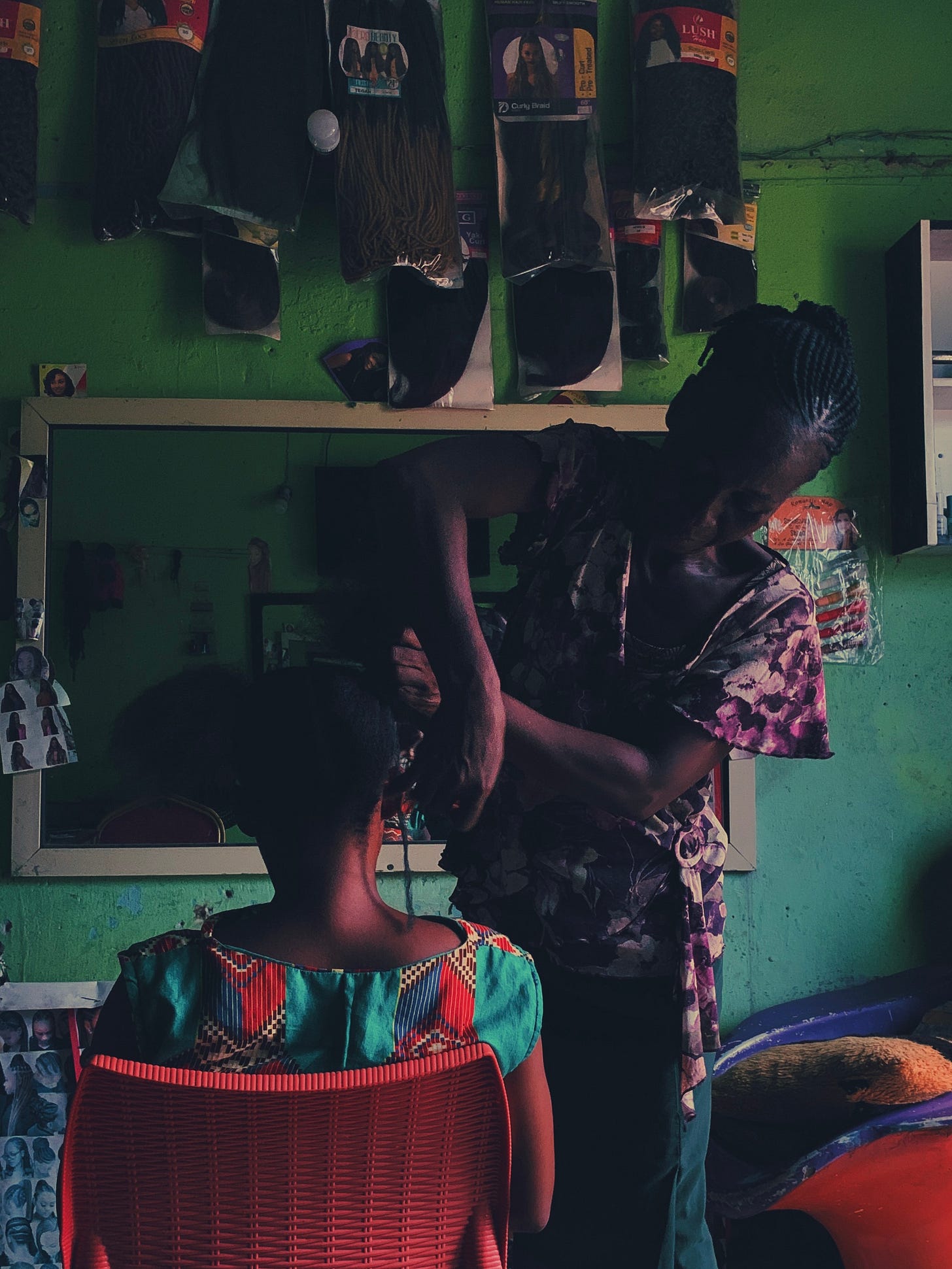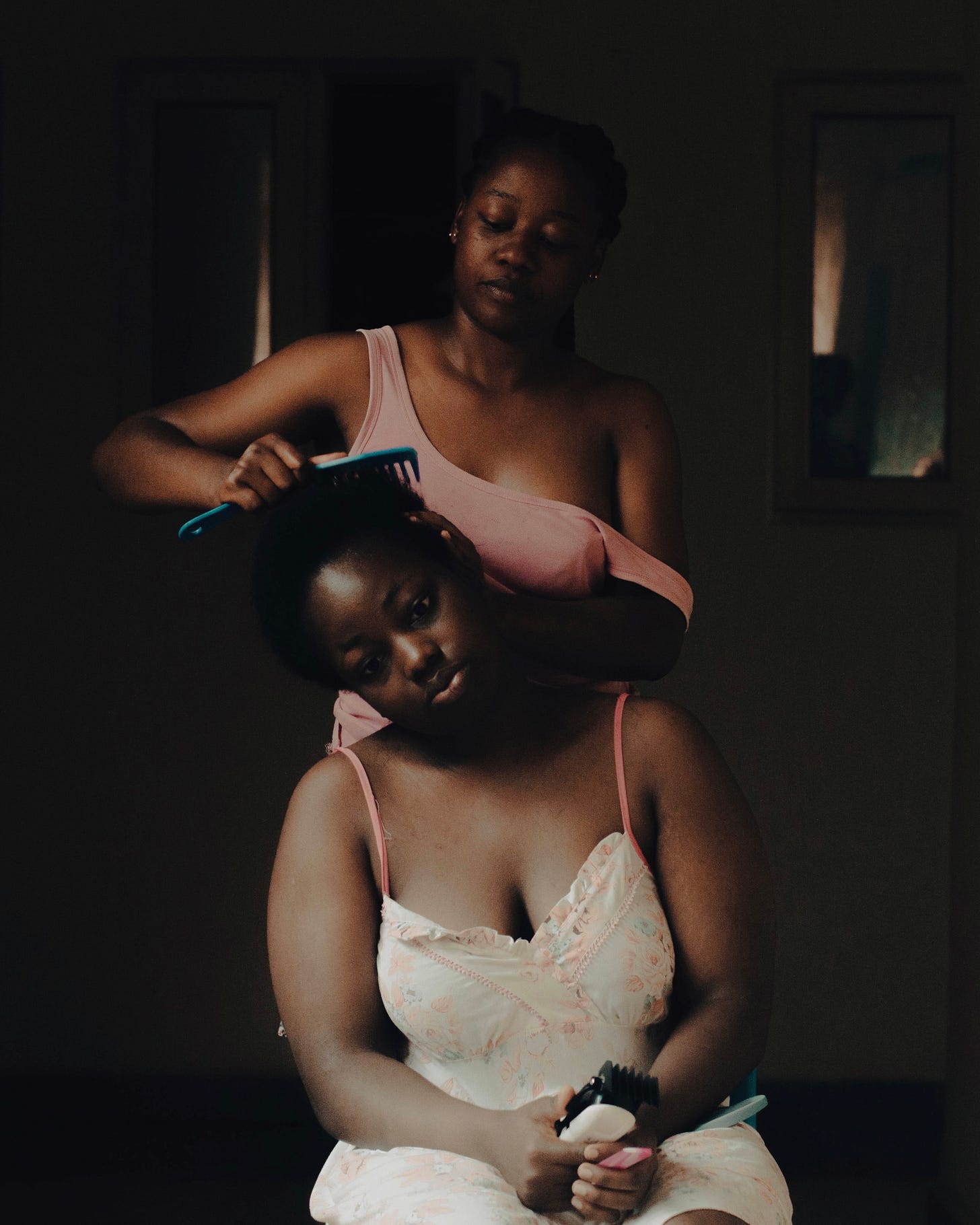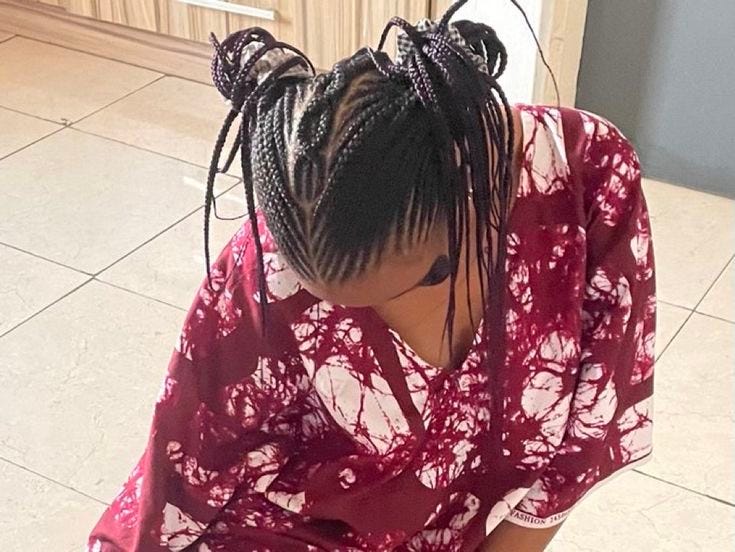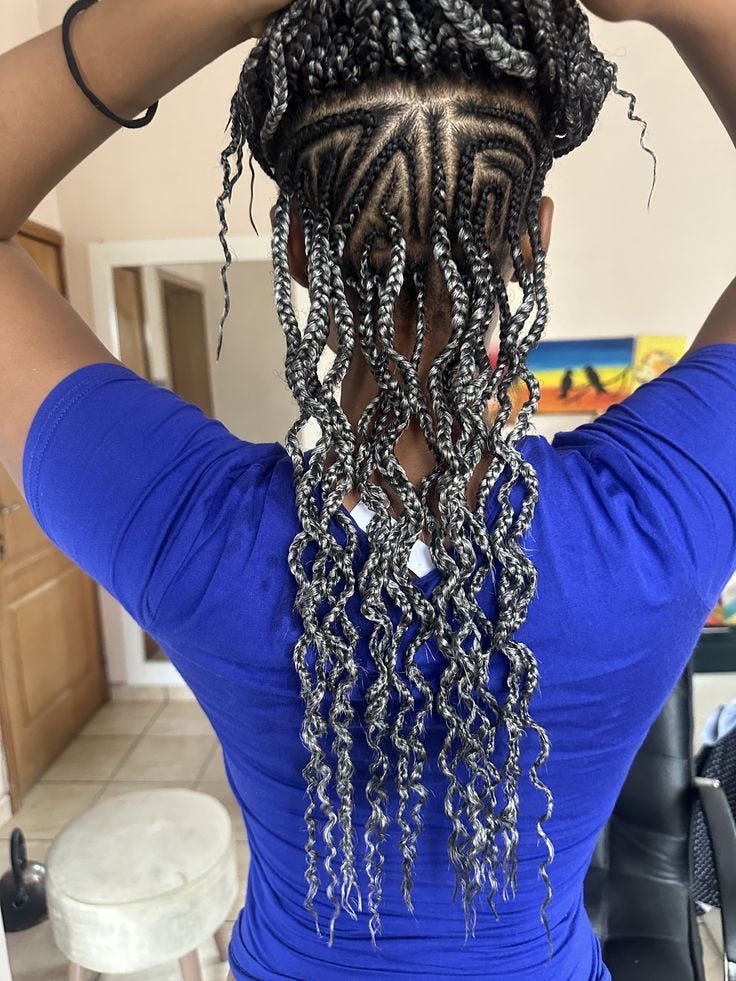The Reclamation of Appearance through THE QUEER VESSEL’S HAIR.
Hair becomes archive. Hair becomes an altar. Hair becomes agency. Written by Irawo.
I have fallen in motherly love with my hair stylist
Conservative realms inspire newer ways to unravel one’s soul and identity. In societies where one’s individuality is cut short and eyed up-down, left-right, with them landing in the center, it’s only right to create a space to unravel in a form that is just so expressive that it gives life to the vessel and by proxy, the within.
Like a child that finds a way to shift the metal bar so far left that their body slides to the window just to see their friends at night, an individual with a personality and thirst for expression shifts the bar of normalcy for the rest of the world to adjust in their favour or maybe not; either way, the catch-up happens. The vessel of the queer is a blank slate for bar shifting. A puncture here and a drawing there, A symbol to mark ‘I was here’, the choice and thought process of outfit choices— the tool of visual vessel design that moulds the flesh to match the within.
The hair.
The ‘Orí’ refers to one’s person, their destiny, the entirety of them— their divine self. As words have been shrunk and reduced, ‘Orí’ is said to directly translate to ‘head’. Perhaps the head is a more understandable way to describe the entirety of an individual because it takes charge of all actions and activities. I beg to differ, but I leave it at that.
“Orí” as in head— the digestible meaning holder of the divine self holds the crown, your hair. If your hair is as mine— thick, high, and wide, I hope you sing its praises, for it holds the highest honour and glory. I hope you engage in love rituals. I hope you’re also in love. I hope you let the crown exist as a spirit of its own as it flows and sways, grows and flourishes, dies and comes alive.
In the places that force one to shrink, the hair stands held high despite. It’s the hair’s natural state. Nurturing and folding one’s hair to expand the within is of the queer. To cut, To experiment, To grow, To fondle with, To curate styles that do not sit in one place, To wash in dye that brightens the colour— To reshape, renew and match vessel to soul.
Hair as an act of Intimacy and Community Enhancement.
I know a woman. Her name is Aunty Rukkayah, and she does my hair. I believe you might know an aunty Rukkayah too. I have built an emotional connection with her from simply braiding my hair with her every month for a year. The first time she touched my hair, it felt like understanding need not have been communicated through words. The hairstyle was dolly braids, and the curls were not dropping as they should have. She looked at me and then at the reference picture, and got the job done. If one is willingly ready to learn your hair, carefully and gently, there is a connection to be nurtured. Lovers are the usual go-to with hair and connection manifesting, but I have fallen in motherly love with my hair stylist. Through hair, we nurture communities and relationships, rendering each other responsible for our perceptions and outlook— building trust and exercising surrender to vulnerability.
Braiding, the act of hair styling common to my people, is often communal: one head between another’s legs as we knew as children, passing strands just before fingers touch, conversations flowing, fingers working instinctively in a rhythm learned from aunties, mothers, and older cousins. This process is sacred. As BraidsMatch.com wrote, “Braiding is a bonding ritual… a quiet way we hold each other.” In queer communities, especially those estranged from biological families, these intimate acts become crucial moments of kinship. The room that holds the chair, ground, or stool sat on transforms into a sanctuary. Hair carries memories. The act of braiding has, historically, encoded messages of resistance.
If one is willingly ready to learn your hair, carefully and gently, there is a connection to be nurtured.
During the transatlantic slave trade, enslaved Africans wove escape routes into their hair as cornrow patterns mirrored rivers or maps, and even seeds were hidden for survival in new lands. These styles became secret languages of resistance and survival. That same power of coded meaning resurfaces today through queer affirmation. Today, those same roots are being reactivated by queer people of African descent, using braids to encode gender play, pride, and political refusal. It can take the form of the overlapping cornrows on the scalp of the lesbian as a flagging technique, which is my preferred method.
Not all queer stories about hair are about pain or defiance. Some are rooted in joy. As seen in Reddit threads, queer users talk about learning to braid their own hair, having partners style their hair, or feeling gender euphoria from simple twists. One user writes: “Now my wife braids my hair, and I love it so much.” Another shares how braiding became a therapeutic process during their gender transition. These experiences center care and intimacy.
I can rest while getting my hair done, and my rest is a political stunt when society urges the body to work endlessly and tirelessly without time to nurture the vessel.
Hair as a Defiance From The Structural Norm
With five fingers on one hand, I can count the things that are within control, and appearance falls in. It can change according to feeling, connection, character, presence, but most definitely, preference. For the gender non-conforming vessel, hair offers a way to communicate identity without words and with ease. I can settle in peacefully in the moment that my scalp is being tucked and nudged for my beautyfulness. I can rest while getting my hair done, and my rest is a political stunt when society urges the body to work endlessly and tirelessly without time to nurture the vessel. My head, once burdened by noise, is now held. My hair is being braided, twisted, and shaped, and in this moment, I am resting. It is a rejection of a society that measures our worth by our output. Under capitalism, we are made to feel that stillness is laziness. That beauty is frivolity. That self-care is indulgence. But to sit in a chair for hours, to feel your head cared for by someone else’s hands, to allow yourself to be present in your body without urgency despite the pain of neck bends and bum to chair positioning, is sacred. That is refusal. That is resistance.
Getting one’s hair done, especially in Black and queer communities, isn’t maintenance as it has been acclaimed to be by social media lingo. It is an enhancement in which its necessity lies in self-expression and not the need to be” put together” or “maintained”. And language used matters.
For many queer people, especially those estranged from systems of traditional safety, whether that’s family, church, or gender roles, getting your hair done becomes part of a form of chosen kinship. And in that act of existing without performance, without labor, you do what the structure does not want you to do. You are nurturing the self. You are protecting the vessel. You are stepping outside the speed of the machine and letting your roots breathe. Hair becomes archive. Hair becomes an altar. Hair becomes agency. To braid, to sit still, to be tender with yourself or let someone else be tender with you— this is how we remember we are not machines. This is how we remember we are alive.
About the Writer:
Hello, I’m Irawo. I experience love for a living. For more stories, unlike & maybe, like this— Find me on Medium @experiencinglove or maybe, Twitter (X) @sunsettingonsea if you feel a fleeting way about words.
Photographers Featured:
Aleruchi Kinika- @aleruchi.kinika
Abdullahi Ali- @shotbyabdullahi






